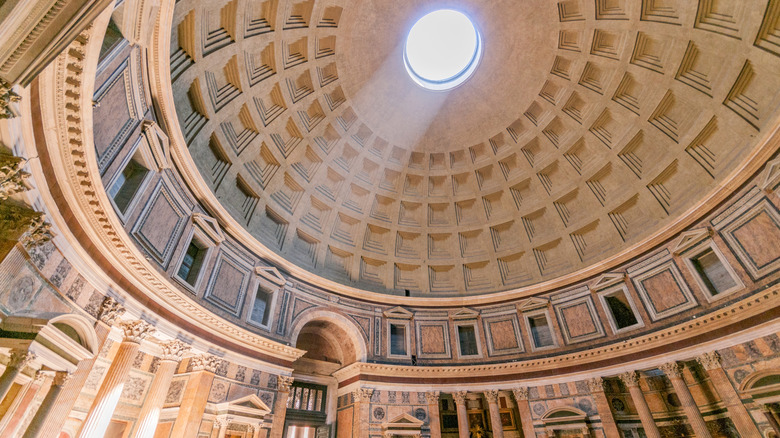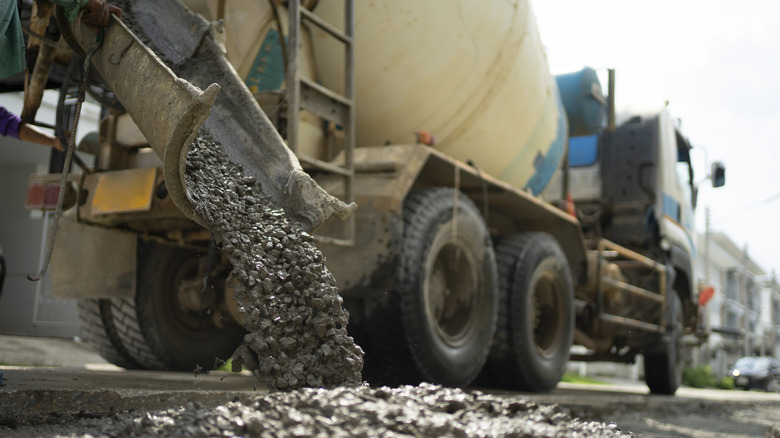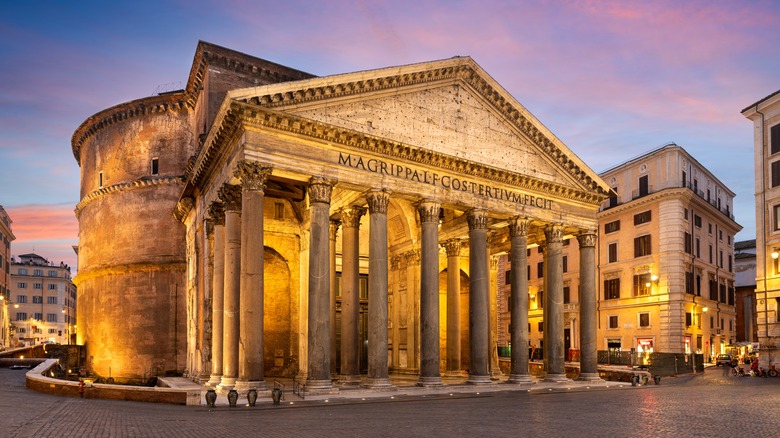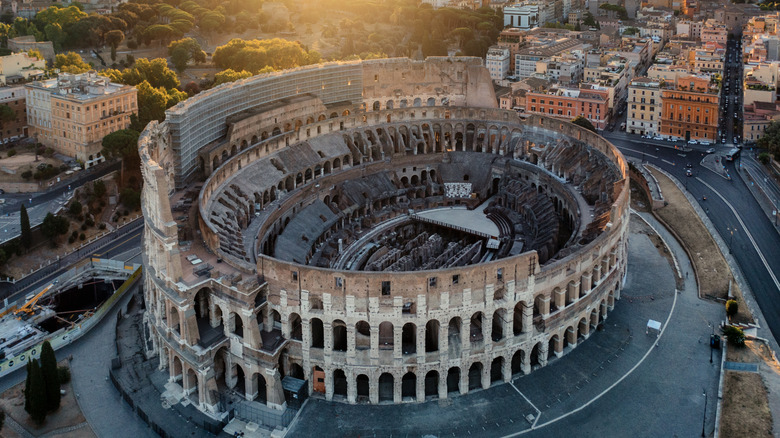The Secret To Why Roman Concrete Lasts So Long
Who among us hasn't driven over modern concrete roads playing a game of "swerve around the tire killer or go ta-chunk in the pothole"? Yeah, concrete seems like a crap material. Sure, it's cheap, convenient, easy-to-make, versatile, and municipal workers can always (eventually) get around to plugging those potholes. But here's a question for you: If concrete is such garbage, then why are buildings like the Roman Collosseum and Pantheon still standing? Does anyone think that the nearest strip of highway is going to be intact 2,000 years from now? Hah.
Looking at the Pantheon, it boasts the oldest, unreinforced concrete dome in the world. That dome has withstood not only the passage of time but the bombardment of the elements. And from the outside, it looks barely older than the stained concrete wall of a local supermarket from the '80s. The original structure — possibly a temple — was built in 25 B.C.E., burned down in 80 C.E., burned down again in 110 C.E., and reached its final, current state from 126 to 128 C.E. Since then, it's stayed precisely as it is.
So what was the Roman secret? Did they have some super special way of mixing or pouring concrete? Why yes, they did. The details are quite technical, but they largely derive from the temperature at which concrete is mixed plus some particular ingredients. Roman concrete was mixed at an extremely hot temperature and contained quicklime, which in the end produced a kind of self-healing concrete.
The modern concrete-mixing method
The modern concrete industry is colossal. As Fortune Business Insights reports, the global market for ready-mix concrete — a slurry of cement, water, and aggregate (blended) ingredients like sand and gravel — reached nearly $1 trillion USD in 2024. By 2032, this figure will double. This kind of ready-mixed concrete gets shipped all over the world to job sites and poured into shape. Wait till it hardens and presto: You're done. The details get complicated beyond such broad strokes, but it's those details that explain the difference between modern concrete and the far more durable Roman mixture.
It's easiest to think of concrete like pancake batter made from a dry material, a wet material, and other stuff that binds it together. The dry material is cement, a powdery substance made from a whole bunch of crushed, ground, heated, and mixed ingredients like lime, magnesium, aluminum, iron oxide, etc. The wet material is water. That other stuff is aggregate materials like sand and gravel. When all three get mixed together, chemical reactions occur that, when allowed to settle, form the hard, porous, stone-like substance we call concrete.
Even though ratios of cement, water, and aggregates vary, the modern concrete-making process and ingredients are standardized. But back in Ancient Rome, Romans tinkered and found a way that produced a far more resilient verison of concrete (one of the many things they couldn't live without). They used the same fundamental components — cement, water, and aggregates — but mixed them at high temperatures. They also used a secret ingredient: quicklime.
On the hunt for Roman secrets
Much has been said about the brilliance of Roman engineering, a stand-out feature of the society along with its military prowess and highly structured government. All three of those features share one common theme: organization. The Romans were meticulously organized and standardized whatever they could, right down to rectangular urban planning and a suite of standard facilities like bathhouses installed in new or conquered towns. And while we don't know how their concrete-making method got started, or who did it, or how long it took to iterate and optimize, the end result speaks for itself. It's not just big, impressive buildings like the Pantheon that have survived — sewers, docks, and seawalls have also withstood millennia of punishment and harsh conditions.
This is why modern material sciences have been trying to figure out the Romans' work for decades. Only as recently as 2023 did a team of investigators from MIT and Harvard work with laboratories in Italy and Switzerland get to the bottom of things. The results were published in the journal of Science Advances in 2023 and explain how one clue cracked the discovery open: Tiny, millimeters-wide white chunks speckling the interior of Roman concrete. Researchers previously believed that these chunks, called lime clasts, were the result of poor mixing on the part of the Romans — kind of like clumps in our pancake batter analogy. But as it turns out, those clumps grew inside the concrete in response to the presence of water, which sealed off cracks and prevented further liquid from getting inside.
The Roman concrete-mixing method
As MIT explains and we said, researchers previously thought that the white clumps in Roman concrete — lime clasts — were the result of imperfect mixing. The Romans, it was believed, mixed powdered lime with water to make "slaked lime" and then combined it with other materials. But as MIT engineer Admir Masic said, "The idea that the presence of these lime clasts was simply attributed to low quality control always bothered me ... There has to be more to the story."
Indeed, there was. As it turns out, the Romans didn't use slaked lime, they used quicklime. Quickline is a dry substance made from putting calcium carbonate — the powdery, chemically active component of lime — directly into the fire of a superhot kiln over 1,800 degrees Fahrenheit. The whole process is very delicate and volatile and can produce poisonous fumes. But afterward, the Romans took this quicklime and mixed it with the rest of their ingredients, like volcanic ash called pozzolan from the Bay of Naples. The Romans shipped this one kind of very specific ash all across the empire to make concrete.
In the end, this Roman concrete-making process creates little pockets in the concrete that seal up after coming into contact with water — hence the lime clasts that researchers discovered. This means that Roman concrete begins at its most brittle and actually grows firmer and stronger over time as it's exposed to the elements, particularly saltwater. The bad news for us? Modern building methods don't have time to wait for concrete to strengthen like this. Looks like we're stuck with the crappy stuff.



